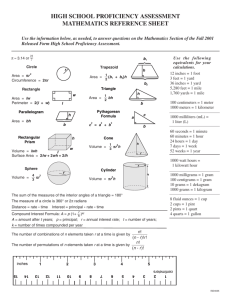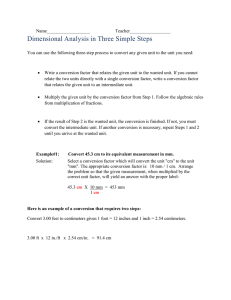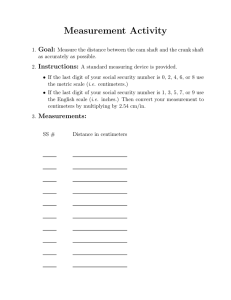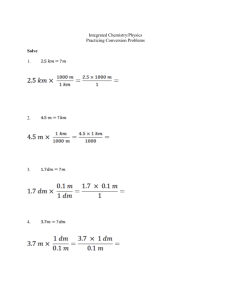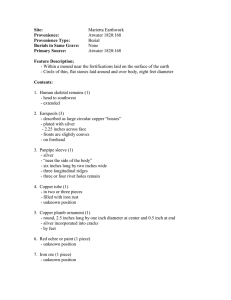CHAPTER 1 THE TOOLS OF CHEMISTRY
advertisement
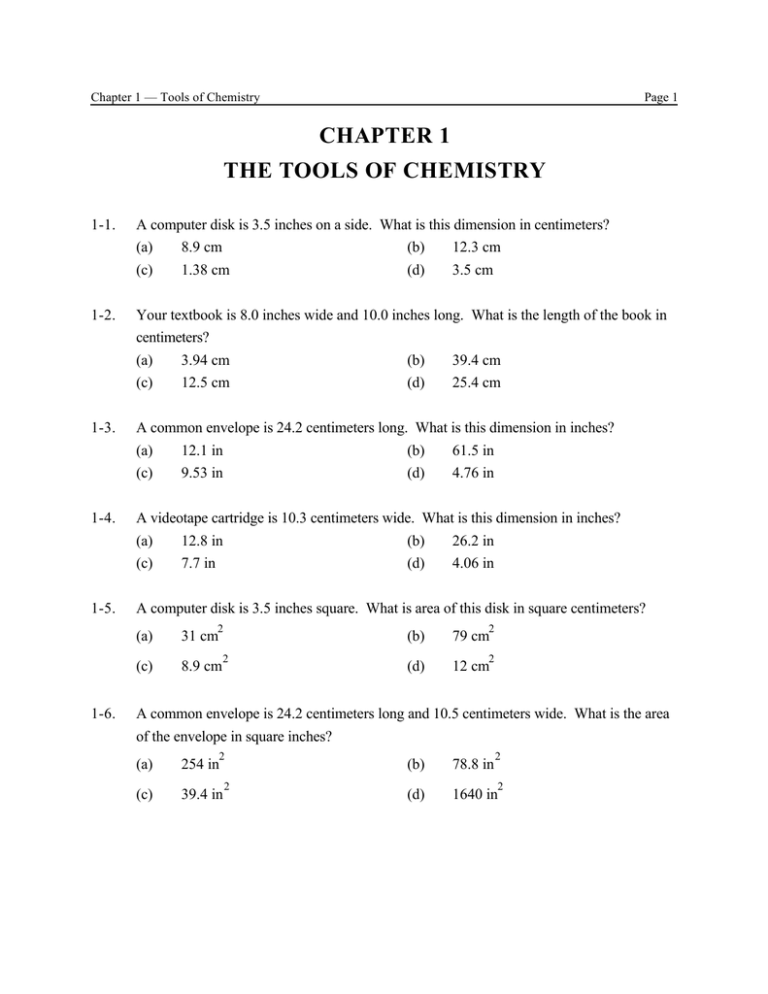
Chapter 1 — Tools of Chemistry Page 1 CHAPTER 1 THE TOOLS OF CHEMISTRY 1-1. A computer disk is 3.5 inches on a side. What is this dimension in centimeters? (a) 8.9 cm (b) 12.3 cm (c) 1.38 cm (d) 3.5 cm 1-2. Your textbook is 8.0 inches wide and 10.0 inches long. What is the length of the book in centimeters? (a) 3.94 cm (b) 39.4 cm (c) 12.5 cm (d) 25.4 cm 1-3. A common envelope is 24.2 centimeters long. What is this dimension in inches? (a) 12.1 in (b) 61.5 in (c) 9.53 in (d) 4.76 in 1-4. A videotape cartridge is 10.3 centimeters wide. What is this dimension in inches? (a) 12.8 in (b) 26.2 in (c) 7.7 in (d) 4.06 in 1-5. A computer disk is 3.5 inches square. What is area of this disk in square centimeters? 1-6. 2 (a) 31 cm (c) 8.9 cm 2 2 (b) 79 cm (d) 12 cm 2 A common envelope is 24.2 centimeters long and 10.5 centimeters wide. What is the area of the envelope in square inches? 2 (a) 254 in (c) 39.4 in 2 2 (b) 78.8 in (d) 1640 in 2 Chapter 1 — Tools of Chemistry Page 2 1-7. A beaker in the laboratory has a volume of 250. mL. What is the volume of the beaker in liters? (a) 0.250 L (b) 250,000 L (c) 2.00 L (d) 2.50 L 1-8. A laboratory flask has a volume of 0.750 L. What is the volume of this flask in milliliters? (a) 75.0 mL (b) 750. mL (c) 0.750 mL (d) 7.50 mL 1-9. A large orange has a mass of 253 g. What is the mass of this orange in kilograms? (a) 2.53 kg (b) 253,000 kg (c) 0.560 kg (d) 0.253 kg 1-10. A piece of meat has a mass of 1.55 kg. What is the mass of this meat in grams? (a) 1550 g (b) 0.155 g (c) 15.5 g (d) 155 g 1-11. A piece of meat has a mass of 1.35 kg. What is the mass of this meat in pounds? (1.00 pound is equivalent to 454 g.) (a) 2.70 lb (b) 0.340 lb (c) 2.97 lb (d) 0.00297 lb 1-12. A can of soft drink has a mass of 1.23 pounds. What is its mass in grams? (1.00 pound is equivalent to 454 g.) (a) 279 g (b) 454 g (c) 19.7 g (d) 558 g 3 1-13. The density of platinum metal is 21.4 g/cm . If you have a piece of platinum with mass of 11.23 g, what is its volume in cubic centimeters? (a) 240. cm (c) 24.0 cm 3 3 (b) 0.525 cm (d) 1.91 cm 3 3 Chapter 1 — Tools of Chemistry Page 3 3 1-14. The density of ethylene glycol, the principal ingredient in antifreeze, is 1.11 g/cm . If you have 245 g of the liquid, how many cubic centimeters do you have? 3 (a) 221 cm (c) 245 cm 3 3 (b) 272 cm (d) 199 cm 3 3 1-15. The density of liquid mercury is 13.53 g/cm . If you have a pound of mercury (454 g), how many milliliters do you have? (a) 6140 mL (c) 0.0298 mL (b) (d) 33.6 mL 454 mL 3 1-16. You have 15.5 grams of ethyl alcohol with a density of 0.789 g/cm . How many milliliters of alcohol do you have? (a) 14.7 mL (c) 16.3 mL (b) (d) 12.2 mL 19.6 mL 1-17. Bromine, one of the few elements that exists in the liquid state under normal conditions, 3 has a density of 3.10 g/cm . If you have 50.0 mL of bromine, how many grams do you have? (a) 16.1 g (c) 155 g (b) (d) 53.1 g 46.9 g 1-18. The temperature of the room is 75 ˚F. Approximately what is its temperature in Celsius degrees? (a) 24 ˚C (b) 77 ˚C (c) 43 ˚C (d) 59 ˚C 1-19. A temperature on a cool day in San Francisco may be 15 ˚C. Approximately what is this temperature in Fahrenheit degrees? (a) 85 ˚F (c) 47 ˚F (b) (d) 59 ˚F 27 ˚F Chapter 1 — Tools of Chemistry Page 4 1-20. The temperature of a hot tub or spa is 104 ˚F. What is this temperature in ˚C? (a) 58 ˚C (b) 76 ˚C (c) 40. ˚C (d) 52 ˚C 1-21. The temperature of molten aluminum is 683 ˚C. What is this temperature in degrees Kelvin? (a) 363 K (b) 410. K (c) 651 K (d) 956 K 1-22. If the temperature of dry ice is -78 ˚C, what is its temperature in degrees Kelvin? (a) 351 K (b) -195 K (c) 195 K (d) 241 K 1-23. The number of significant figures in the number 0.002354 is (a) 6 (b) 3 (c) 2 (d) 4 -3 1-24. The number of significant figures in the number 1.03 x 10 is (a) (c) 1 2 (b) (d) 3 4 1-25. If you solve the expression (2.34 + 0.567 + 63.2 = ?), the answer is (a) 66.107 (b) 66.10 (c) 66.1 (d) 66 1-26. What is the answer to the following expression in the correct number of significant figures? (0.0821) • (0.023) • (298) / 1.5 (a) 0.38 (b) 0.4 (c) 0.375 (d) 0.37514227 Chapter 1 — Tools of Chemistry Page 5 1-27. If you express the number 0.000568 in scientific notation with two significant figures it would be (a) 5.7 x 10 (c) 5.7 x 10 -3 4 (b) 5.68 x 10 (d) 5.7 x 10 -4 -4 1-28. Fourteen carat gold is a mixture of gold and other metals, with gold present to the extent of 58.3%. If you have a 14-carat gold ring with a mass of 5.63 g, the mass of gold present is (a) 0.305 g (b) 2.35 g (c) 3.28 g (d) 4.80 g 1-29. Silver jewelry is a mixture of silver and copper. If a bracelet has a mass of 23.56 g, and it is 80.1% silver, the mass of silver in the bracelet is (a) 18.9 g (b) 0.215 g (c) 4.69 (d) 21.3 g 1-30. Silver jewelry is a mixture of silver and copper. If an earring has a mass of 1.78 g, and it is 80.1% silver, the mass of copper in the earring is (a) 0.98 g (b) 1.35 g (c) 1.43 g (d) 0.35 g 3 1-31. A solution of sugar in water has a density of 1.05 g/cm . If you have 75 mL of the solution, and if the solution is 8.1% sugar, how many grams of sugar are there in the solution? (a) 63.8 g sugar (b) 6.4 g sugar (c) 60.8 g sugar (d) 6.1 g sugar -12 1-32. Molecular distances are given in picometers, where 1 pm is equivalent to 1 x 10 -8 meter. If the distance between carbon atoms in a diamond is 1.54 x 10 cm, what is this distance in picometers? (a) 154 pm (c) 1.54 cm (b) (d) 0.154 cm 154,000 cm Chapter 1 — Tools of Chemistry Page 6 1-33. You can identify a metal by carefully determining its density. An unknown piece of metal, with a mass of 29.454 g, is 2.35 cm long, 1.34 cm wide, and 1.05 cm thick. Which element do you have? (a) Nickel, 8.91 g/cm (c) Zinc, 7.14 g/cm 3 3 3 (b) Titanium, 4.50 g/cm (d) Tin, 7.23 g/cm 3 3 1-34. Zinc has a density of 7.14 g/cm . If you have a piece of zinc that is 0.20 cm thick, 1.5 cm wide, and 3.0 cm long, the mass of the piece is (a) 0.13 g (b) (c) 0.64 g (d) 6.4 g 64 g 9 1-35. In 1989 53.77 billion pounds (53.77 x 10 ) of nitrogen gas were used in industry in the United States. If 1.00 pound is equivalent to 453.6 g, how many kilograms of nitrogen were produced? (a) 2.439 x 10 (c) 2.439 x 10 10 13 8 kg (b) 1.185 x 10 kg kg (d) 1.185 x 10 kg 5 1-36. Tin foil is 92.0% tin and 8.0% zinc. If you have 0.500 pound of tin foil, how many grams of tin do you have? (1.00 pound is equivalent to 454 g.) (a) 460. g (b) 418 g (c) 209 g (d) 227 g 1-37. A pure silver coin has a mass of 4.10 g and a diameter of 1.54 cm. If the density of silver 3 is 10.49 g/cm , how thick is the silver coin? (A cylinder, such as a coin, has a volume of 2 π • r • thickness, where r is the radius of the coin.) (a) (c) 0.0525 cm 5.63 cm (b) (d) 0.210 cm 1.41 cm Chapter 1 — Tools of Chemistry Page 7 1-38. A floor is painted with 750. mL of paint. If the floor to be covered is 20.0 ft by 18.0 ft, how thick is the paint layer? (a) 2.08 cm (b) 0.0145 cm (c) 0.00224 cm (d) 0.0234 cm 1-39. A ball of iron, which may be used in the “shotput” event at a track meet, has a mass of 16.0 3 pounds. If the density of iron is 7.874 g/cm , and if 1.00 pound is equivalent to 454 g, 3 what is the diameter of the iron ball? (The volume of a sphere is (4/3) • (π) • r , where r is the radius of the sphere.) (a) 24.0 cm (c) 9.23 cm (b) (d) 12.1 cm 6.08 cm 1-40. You have purchased a piece of highly pure iron foil for $55.00. The foil is 50. mm square 3 and 1.00 mm thick. What is the cost per gram of foil? (Density of iron = 7.874 g/cm .) (a) (c) $2.79 / gram $0.36 / gram (b) (d) $0.28 / gram $5.50 / gram 1-41. You want to purchase some very pure iron wire. If wire with a thickness of 2.00 mm costs $54.10 for 24.8 grams, how many centimeters of wire can you buy for $100.00? (The 2 volume of a piece of wire is given by π • r • length, where r is the radius of the wire.The 3 density of iron is 7.874 g/cm .) (a) (c) 5.82 cm 185 cm (b) (d) 100. cm 1.85 cm 1-42. Which of the following is a chemical property of iron? 3 (a) Density = 7.874 g/cm (b) Iron melts at 1808 K. (c) Iron corrodes in moist air. (d) Iron is soft when pure. 1-43. Aluminum metal melts at 934 K. Is this a description of a chemical or physical property of aluminum? (a) chemical (b) physical Chapter 1 — Tools of Chemistry Page 8 1-44. Sodium reacts violently with water to give a gas and an alkaline solution. Is this a description of a chemical or physical property of sodium? (a) chemical (b) physical 1-45. Elemental fluorine is a gas with a boiling point of -188 ˚C. The element reacts vigorously with water. Which of these statements tells us about a chemical property of the element? (a) Boiling point. (b) Reaction with water. 1-46. You have 25.0 mL of orange, liquid bromine. Which part of this statement refers to qualitative information? (a) 25.0 mL (b) orange, liquid 1-47. You have a jar of chunky peanut butter. Is this a homogeneous or heterogeneous mixture? (a) homogeneous (b) heterogeneous 1-48. Which of the following is NOT a unit in the SI system of units? (a) kilogram (b) second (c) inch (d) meter 1-49. A beautiful blue copper compound dissolves completely in water. Which statement is correct? (a) The copper compound is the solute and the water is the solvent. The solution is homogeneous. (b) The copper compound is the solvent and the water is the solute. The solution is homogeneous. (c) The copper compound is the solute and the water is the solvent. The solution is heterogeneous. (d) The copper compound is the solvent and the water is the solute. The solution is heterogeneous. Chapter 1 — Tools of Chemistry Page 9 3 1-50. Aluminum has a density of 2.699 g/cm . If you have a block of aluminum with a mass of 434 pounds, how many meters of wire can be made from this block if the wire has a 2 diameter of 2.5 mm? (The volume of the wire is given by π • r • l where l is the length of the wire and r is its radius. There are 453.6 g per pound.) (a) 8.2 meters (b) 37 meters (c) 2 9.3 x 10 meters (d) 4 1.5 x 10 meters ANSWERS — CHAPTER 1 1. 2. 3. 4. 5. 6. 7. 8. 9. 10. a d c d b c a b d a 11. 12. 13. 14. 15. 16. 17. 18. 19. 20. c d b a b d c a b c 31. 32. 33. 34. 35. 36. 37. 38. 39. 40. b a a b a c b c b a 41. 42. 43. 44. 45. 46. 47. 48. 49. 50. c c b a b b b c a d 21. 22. 23. 24. 25. 26. 27. 28. 29. 30. d c d b c a d c a d
